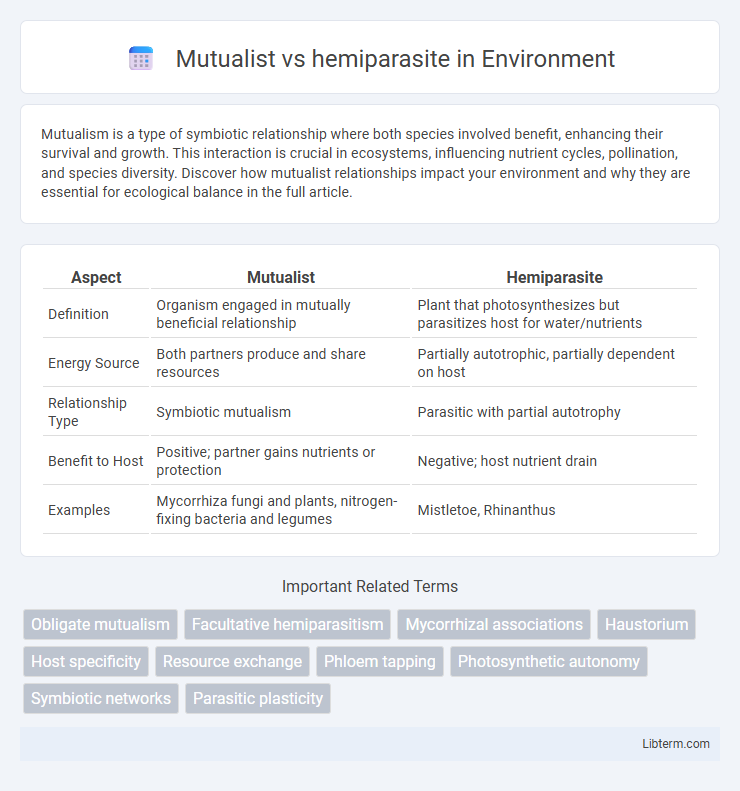Mutualism is a type of symbiotic relationship where both species involved benefit, enhancing their survival and growth. This interaction is crucial in ecosystems, influencing nutrient cycles, pollination, and species diversity. Discover how mutualist relationships impact your environment and why they are essential for ecological balance in the full article.
Table of Comparison
| Aspect | Mutualist | Hemiparasite |
|---|---|---|
| Definition | Organism engaged in mutually beneficial relationship | Plant that photosynthesizes but parasitizes host for water/nutrients |
| Energy Source | Both partners produce and share resources | Partially autotrophic, partially dependent on host |
| Relationship Type | Symbiotic mutualism | Parasitic with partial autotrophy |
| Benefit to Host | Positive; partner gains nutrients or protection | Negative; host nutrient drain |
| Examples | Mycorrhiza fungi and plants, nitrogen-fixing bacteria and legumes | Mistletoe, Rhinanthus |
Understanding Mutualists and Hemiparasites
Mutualists form symbiotic relationships where both species benefit, such as nitrogen-fixing bacteria in plant roots enhancing nutrient uptake. Hemiparasites are partially parasitic plants that extract water and nutrients from host plants while still performing photosynthesis independently. Understanding these interactions highlights the balance between cooperation and resource dependency in ecological systems.
Defining Mutualism in Plant Interactions
Mutualism in plant interactions involves a symbiotic relationship where both species benefit, such as legumes hosting nitrogen-fixing bacteria that enhance soil fertility and plant growth. Mutualists exchange resources or services that increase survival and reproduction for both partners, contrasting hemiparasites that extract water and nutrients from host plants, often reducing host fitness. Understanding mutualism emphasizes cooperative interactions improving ecosystem productivity and species resilience, distinguishing it from parasitic strategies.
What Are Hemiparasitic Plants?
Hemiparasitic plants partially rely on other plants for water and nutrients while still performing photosynthesis, distinguishing them from mutualists that engage in reciprocal beneficial relationships. These plants attach to host roots or stems using specialized structures called haustoria to extract resources. Common examples include mistletoes and some species of dodder, which balance parasitism and autotrophy within their lifecycle.
Key Differences: Mutualists vs Hemiparasites
Mutualists engage in a symbiotic relationship where both species benefit, such as mycorrhizal fungi enhancing plant nutrient uptake while receiving carbohydrates. Hemiparasites partially rely on their host plants for water and nutrients but retain photosynthetic ability, exemplified by mistletoes extracting xylem sap while producing their own sugars. Key differences include the nature of interaction--mutualism involves reciprocal benefit, whereas hemiparasitism involves unilateral resource extraction--and the degree of host dependence, with mutualists generally benefiting both organisms and hemiparasites imposing a cost on the host.
Ecological Roles and Contributions
Mutualists engage in reciprocal interactions that enhance the survival and reproduction of both participating species, often contributing to nutrient cycling and ecosystem stability. Hemiparasites partially depend on their host plants for water and minerals while still performing photosynthesis, influencing host growth and community composition by selectively extracting resources. Both mutualists and hemiparasites drive ecological dynamics by shaping species interactions, promoting biodiversity, and affecting energy flow within ecosystems.
Impact on Host Plants and Ecosystems
Mutualist plants enhance host growth and ecosystem stability by facilitating nutrient exchange or protection, leading to increased biodiversity and soil fertility. Hemiparasites extract water and nutrients from hosts, often reducing host vigor and altering plant community structure, which can lead to shifts in species composition and ecosystem nutrient cycling. The contrasting impacts of mutualists and hemiparasites shape ecosystem dynamics through their positive or negative influence on host plant health and resource availability.
Examples of Mutualistic Relationships
Mutualistic relationships involve interactions where both species benefit, such as the classic example of mycorrhizal fungi and plant roots, where fungi enhance nutrient uptake while receiving carbohydrates. Another notable instance is the mutualism between ants and acacia trees, where ants protect the tree from herbivores and in return, obtain shelter and food from the tree. These examples contrast with hemiparasites, which extract water and nutrients from host plants while also performing photosynthesis, benefiting only one party.
Notable Hemiparasitic Plant Species
Notable hemiparasitic plant species include mistletoes (Viscum album), Indian paintbrush (Castilleja spp.), and dodder (Cuscuta spp.), which partially rely on their host plants for water and nutrients while also performing photosynthesis. These species have specialized haustoria that penetrate host tissues to extract resources, distinguishing them from mutualistic plants that engage in beneficial, reciprocal interactions. Hemiparasites impact ecosystem dynamics by influencing host plant growth and community structure.
Evolutionary Perspectives and Adaptations
Mutualists and hemiparasites represent distinct evolutionary strategies, with mutualists evolving cooperative adaptations that benefit both interacting species through resource exchange and signaling mechanisms. Hemiparasites exhibit evolutionary traits enabling partial independence by photosynthesis while extracting water and nutrients from host plants via specialized structures like haustoria. These adaptations reflect divergent evolutionary pressures, where mutualists optimize bidirectional resource flow and hemiparasites balance autotrophic and heterotrophic modes for survival.
Implications for Biodiversity and Conservation
Mutualist relationships enhance biodiversity by promoting species coexistence and ecosystem resilience through reciprocal benefits, such as nutrient exchange between mycorrhizal fungi and plants. Hemiparasites influence community dynamics by selectively affecting host plant growth, which can increase habitat heterogeneity and create niches for diverse organisms. Conservation strategies that recognize the roles of mutualists and hemiparasites help maintain ecosystem functions and support species richness in threatened habitats.
Mutualist Infographic

 libterm.com
libterm.com